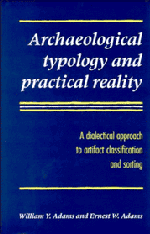 Archaeological Typology and Practical Reality
Archaeological Typology and Practical Reality Book contents
- Frontmatter
- Contents
- List of figures
- List of tables
- The archaeologist's preface
- The philosopher's preface
- PART I Introductory
- PART II The nature of types and typologies
- PART III Typology in action: the Medieval Nubian Pottery Typology
- PART IV Pragmatics of archaeological typology
- 13 The starting point: purpose
- 14 The determinants of types: variables and attributes
- 15 The making of types: formulation, designation and description
- 16 The use of types: typing and sorting
- 17 The ordering of types: taxonomy and seriation
- 18 Variation and variability in archaeological classifications
- 19 The bottom line: practicality
- 20 Principles of practical typology
- 21 Information-theoretic formulations
- PART V Classification, explanation, and theory
- Appendices
- References
- Index
13 - The starting point: purpose
Published online by Cambridge University Press: 23 November 2009
- Frontmatter
- Contents
- List of figures
- List of tables
- The archaeologist's preface
- The philosopher's preface
- PART I Introductory
- PART II The nature of types and typologies
- PART III Typology in action: the Medieval Nubian Pottery Typology
- PART IV Pragmatics of archaeological typology
- 13 The starting point: purpose
- 14 The determinants of types: variables and attributes
- 15 The making of types: formulation, designation and description
- 16 The use of types: typing and sorting
- 17 The ordering of types: taxonomy and seriation
- 18 Variation and variability in archaeological classifications
- 19 The bottom line: practicality
- 20 Principles of practical typology
- 21 Information-theoretic formulations
- PART V Classification, explanation, and theory
- Appendices
- References
- Index
Summary
Critics have been heard to complain that for archaeologists typologies are a kind of fetish, and that classification may become an end in itself (Kluckhohn 1939: 338; Bennett 1943: 208; Hill and Evans 1972: 231, 267; Vierra 1982: 164; Hayden 1984: 81). This view seems to imply that some typologies serve no useful purpose. Usefulness, however, is very much in the eye of the beholder. As individuals we constantly encounter typologies that are of no use to us in our own work; for example, WYA has never found a bead typology that adequately describes the beads from his own excavations in Nubia. It is evident nevertheless that the many existing Nubian and Egyptian bead typologies (e.g. Reisner 1923b: 106–27; Steindorff 1935: 46–50; Emery 1938: pls. 43–4) served the practical needs of their makers, in that they permitted the description of a large and diverse body of material within a limited number of pages (cf. Everitt 1974:4).
If a typology appears to serve no obvious purpose, it probably means only that the typologist neglected to specify what his purpose was. This seems to be a fairly common failing (cf. Gardin 1980: 81). It may also be that the typology-maker was himself not consciously aware of his purpose, something that is perhaps also common (cf. Klejn 1982: 51–4). But we doubt that there are any typologies for which the maker had no purpose at all, either consciously or unconsciously.
- Type
- Chapter
- Information
- Archaeological Typology and Practical RealityA Dialectical Approach to Artifact Classification and Sorting, pp. 157 - 168Publisher: Cambridge University PressPrint publication year: 1991


